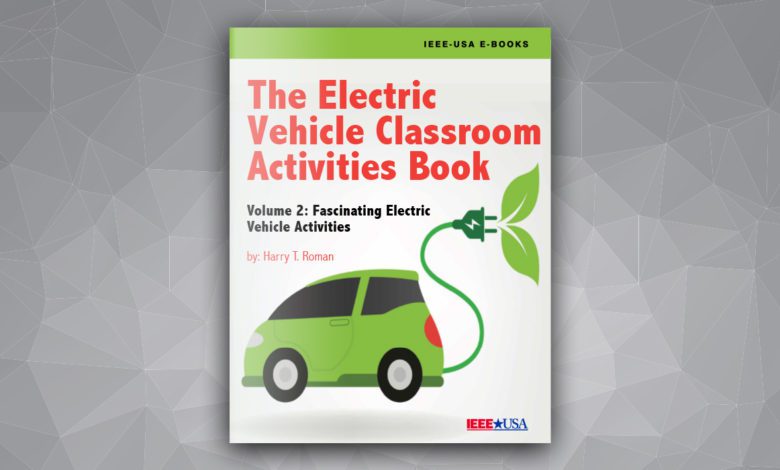

The Electric Vehicle Classroom Activities Book – Vol. 2: Fascinating Electric Vehicle Activities
FREE to IEEE Members
Non-Members: $2.99
Harry T. Roman is back with a second book on electric cars: Electric Vehicle Classroom Activities Book – Volume 2: Fascinating Electric Vehicle Activities. Roman’s newest book helps teachers lead students as they take a 360-degree look at electric cars — examining the technological, environmental, social, cultural, safety and regulatory implications of widespread electric car adoption.
Electric Vehicle Classroom Activities Book – Volume 2: Fascinating Electric Vehicle Activities is available to IEEE members for free at IEEE-USA’s online shop. Non-members pay $2.99
Roman begins the book suggesting a deep dive into batteries, including developing a timeline that shows a battery’s life cycle: from extracting raw minerals to manufacturing, and finally, to end-of-life battery disposal. He suggests students take the opportunity to explore in great detail all areas along the timeline, from examining the environmental impact of mining raw materials to looking at all the options and challenges for recycling used batteries. According to Roman, any negative environmental impacts need to be balanced against the environmental benefits of reduced pollution and reduction in the use of oil and gas.
However, the author pushes student exploration well beyond the environmental impact. For instance, he suggests students brainstorm unexpected economic impacts–such as job reductions at gas stations — and a lessened need for mechanics (electric cars with fewer moving parts need fewer repairs).
Roman also raises questions about public policy — all ripe for students and/or entire classes to explore. Adopting electric cars varies greatly around the nation — due to varying incentives offered by state governments. Roman suggests students investigate what states, and even other countries, have done to increase the public’s adoption of electric cars. (Students might want to start with Norway, where today more than half of new cars sold are electric–in large part, driven by incentives).
Further, he points out that many states fund highway improvements and highway maintenance from taxes on gasoline. How might the gas tax revenues be made up, as increased adoption of electric cars reduces gas consumption? Roman also suggests students look at the silent nature of electric cars, and discuss if this silence should require new safety regulations.
As usual, Roman asks the big questions, but he also brings it closer to home for the students. For instance, he suggests helping students explore:
- Where in your hometown can an electric car owner charge their car — and what additional sites might make sense?
- Where at your school could there be charging stations for teachers, students, and the public to use?
- What are the impacts on fire departments? Do they need to handle accidents and car fires differently, since electric cars have a larger battery and no gas? After exploring on the Internet, Roman suggests a call or visit to the local fire department to see what actual changes to procedures they have implemented as more and more electric cars take to the road.
In a section on Math for Electric Vehicles, Roman suggests students get out their calculators and compare the cost of fueling a car with gasoline and electricity. He walks through how to do the comparison, as well as how students can plug in current local prices for gas and electricity to get a realistic view on the economics for themselves or their families. He suggests, “It is important to make sure the students not just voice opinions with passion but back up their beliefs with math!”
Roman’s second EV book joins the author’s numerous other books — all useful for a teacher or a curious mind. They are available at the IEEE-USA shop at: https://ieeeusa.org/shop/.
Harry T. Roman holds 12 U.S. patents and has received numerous engineering, invention, and teaching awards. The New Jersey Inventors Hall of Fame honored him with an Inventor of the Year award for his application of mobile robots in hazardous work environments, and IEEE honored Roman with a Meritorious Achievement Award, for developing continuing education products for IEEE members. Roman currently teaches a graduate course at Montclair State University on applying STEM techniques in the classroom. He is also an advisor/author to the Edison Innovation Foundation, and docent/special lecturer at the Thomas Edison National Historical Park, in West Orange, NJ.






